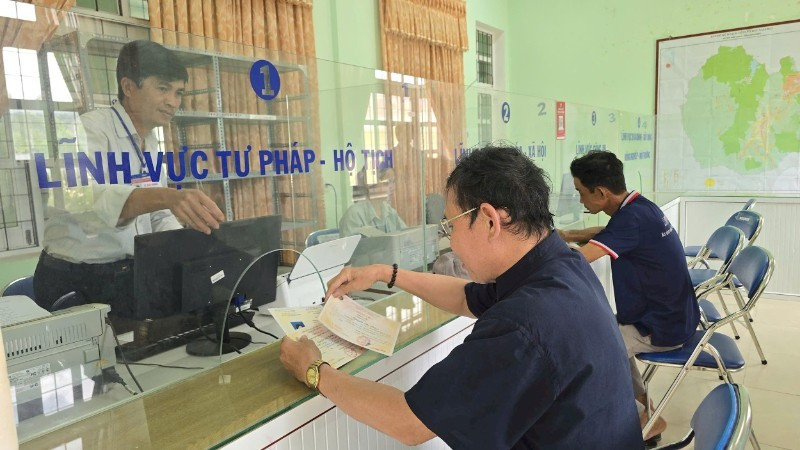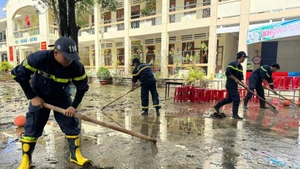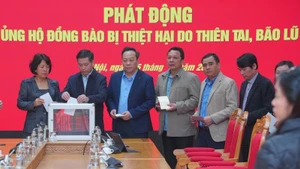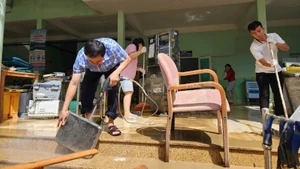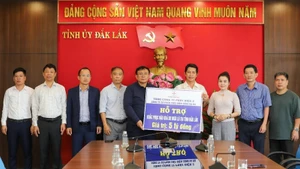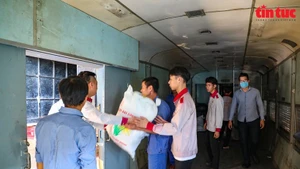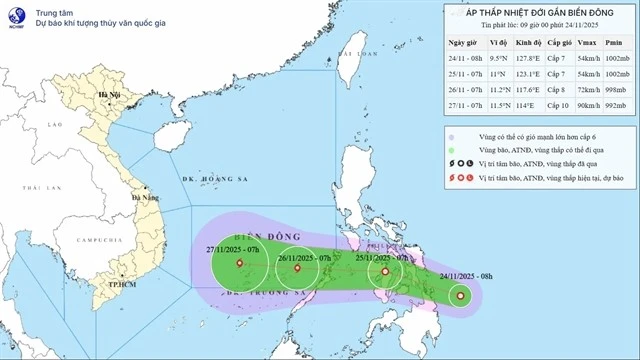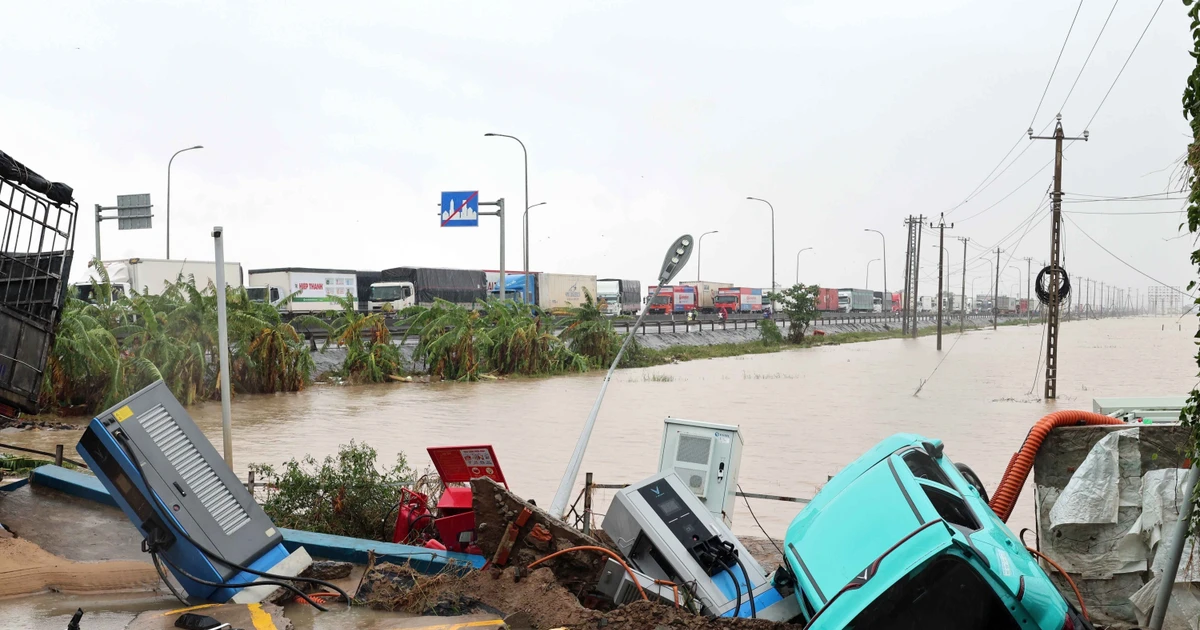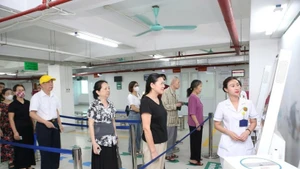Many bottlenecks in personnel, technical infrastructure, and administrative procedures have gradually been resolved, ensuring uninterrupted operation of the system and moving towards building a streamlined, modern administration with citizens at its centre.
Government closer to the people, operating more effectively
Following the merger of provinces and the reorganisation of commune-level administrations, localities have quickly stabilised their organisation and ensured the smooth operation of the two-tier government apparatus, leaving no gap in management or public services.
In Gia Lai Province, many localities have proactively improved administrative procedure reception processes, expanding reception points and processing public administrative records to better serve citizens, especially ethnic minorities in remote areas. Canh Vinh Commune covers nearly 260 km² and is home to many ethnic minority villages. In addition to establishing a Public Administrative Service Centre in the centre, the commune has opened additional reception points for administrative procedure records in Canh Hiep Hamlet and Canh Tien Village.
Duong Hiep Hoa, Chairman of the Canh Vinh Commune People’s Committee, said: “Opening reception points in the hamlets means residents no longer have to travel to the commune centre. The commune provides equipment, internet access, and training for hamlet and village officials to receive and guide citizens with their documents.”
Le Ngoc Trong from Tan Quang Hamlet shared: “I thought I had to travel 20 km to the commune centre to complete procedures. Now I just go to the reception point near my home, get clear instructions from the officials, and have everything done in a single day.”
After the merger of provinces, localities in Thai Nguyen Province have focused on key tasks such as land clearance, speeding up construction progress, disbursing public investment capital, eliminating temporary housing for the poor, and organising commune-level Party congresses. Despite the expansion of commune areas, increased population, and heavier workloads, the quality of service for citizens has clearly improved.
In July, administrative procedure reception points in the province received 82,766 records, with an on-time and early resolution rate of 98.84%, earning satisfaction from citizens and businesses. This was achieved thanks to well-trained professional staff in all 92 communes and wards in professional skills and information technology. In many places, officials work “until the job is done, not until the clock says stop”, with a dedicated, professional spirit of serving the people.
However, in some northern communes of Thai Nguyen Province there are still cases of officials struggling with their duties, shortages of specialised staff, and uneven IT application skills. Chairman of the Thai Nguyen Provincial People’s Committee Pham Hoang Son said the province would mobilise and second 5% of officials from provincial departments to the grassroots level before August 15 to strengthen commune-level capacity.
Ensuring socio-economic targets are met
Following the mergers, commune-level governments have been delegated more than 1,000 tasks, significantly increasing workloads, while the number of officials has not increased. Nevertheless, with a sense of responsibility and innovative service methods, many localities have gradually overcome difficulties and improved service quality.
In Nghe An Province, Cua Lo Ward was established by merging seven wards and communes. With over 64,000 residents, the ward’s Public Administrative Service Centre receives nearly 200 citizens daily for procedures. Deputy Director of the Centre Tran Xuan Vinh said officials are assigned based on their competencies and receive thorough guidance to operate administrative software and procedures smoothly.
Le Nhu Tai from Block 5, Cua Lo Ward, shared: “Previously, to get a building permit, I had to go to the city 15 km away, but now I just go to the ward administrative centre. It saves time and money and is processed quickly, so I am very satisfied.”
In Tam Hop Commune, formed from the merger of four communes, the population has increased to nearly 43,000, with the commune administrative centre receiving more than 100 records daily. The commune has also implemented the “Saturday for the People” model, taking equipment directly to hamlets to process land, civil status, and certification procedures on-site for citizens.
Cao Duc Trung, Secretary of the commune Party Committee, said this approach makes public services more accessible to residents in remote areas.
More than a month after the new apparatus began operating, despite some initial disruptions, localities have remained stable, socio-economic development has achieved positive results, and there is strong public support.
More than a month after the new apparatus began operating, despite some initial disruptions, localities have remained stable, socio-economic development has achieved positive results, and there is strong public support. In Ha Noi, newly established administrative units have quickly adapted to their tasks, ensuring good service for citizens and effective implementation of socio-economic missions.
In Tay Ho Ward, work has begun on upgrading Chu Van An High School with an investment of over 251 billion VND, aiming to bring it up to international standards.
In Hong Ha Ward, the local government is expediting land clearance for 500 households to make way for the Tu Lien Bridge project.
Vinh Hung Ward has been assigned as the investor for expanding Linh Nam Road, involving 98,000 m² of land and nearly 830 households. The ward authorities are actively working with relevant agencies to verify land origins and directly engage with residents. The goal is to complete 90% of land acquisition and compensation payments by the end of 2025.
In Ngoc Hoi Commune, home to the Ngoc Hoi Station complex of the north–south high-speed railway project, resettlement preparations are being accelerated. Commune Party Secretary Nguyen Xuan Phong said: “We plan to start construction of the 10-hectare resettlement area this August to serve the project.”
Gradually overcoming difficulties
Alongside initial positive results, the process of restructuring the apparatus and operational methods still faces challenges, particularly in remote communes. In the A Luoi 1, 2, 3, 4, and 5 communes in Hue City, the operation of IT systems remains difficult due to infrastructure limitations and the capacity of officials.
Pi Loong Mai, Secretary of the Party Committee and Chairman of the People’s Council of A Luoi 5 Commune, shared: “Commune officials are not yet accustomed to the high workload and multi-tasking demands. The city’s timely training courses have helped improve capacity and made the transition smoother.”
Over the past month, the city’s administrative apparatus has operated smoothly, ensuring good service for citizens and businesses. Despite remaining difficulties, the rate of online submissions has reached 88.46%, ranking fifth nationwide.
Nguyen Van Phuong, Chairman of the Hue City People’s Committee
Nguyen Van Phuong, Chairman of the Hue City People’s Committee, affirmed that the city’s administrative apparatus has operated smoothly over the past month, ensuring good service for citizens and businesses. Despite difficulties, the online submission rate has reached 88.46%, ranking fifth nationwide.
In Dong Nai Province, reality has also placed heavy pressure on grassroots officials. Reports indicate that workloads have increased significantly after the mergers, especially in specialised offices. An official in a commune’s culture–society office said: “Previously, each person handled one field, but now one official is responsible for culture, internal affairs, and labour, leading to many being overload.” This has been one reason why some commune and ward officials in Dong Nai have resigned, affecting local governance.
In response, Dong Nai Provincial Party Secretary Vu Hong Van has instructed local Party committees to review and assign officials according to their qualifications and capacities, preventing staff shortages or overlapping duties. On July 29, the Dong Nai Provincial Party Committee issued decisions to assign 37 officials to leadership positions at communes and wards, including several deputy directors of provincial departments assigned to key grassroots posts.
Similarly, Lam Dong Province has seconded 260 officials from the provincial level and 370 police officers, along with 100 soldiers, to support grassroots work. Nearly 2,700 youth union members have been mobilised to form over 130 volunteer teams assisting citizens at administrative centres.
At this point, it can be affirmed that despite many difficulties and challenges, the two-tier local government model nationwide has gradually stabilised its organisation and improved service efficiency. The initial results demonstrate the right direction in administrative apparatus reform, laying the foundation for the country’s sustainable development.
